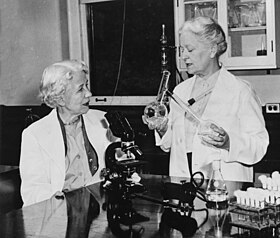
Back راشيل براون (كيميائية) Arabic راشيل براون (عالمه احياء دقيقه من امريكا) ARZ Rachel Fuller Brown AST راشل فولر بران AZB Rachel Fuller Brown Catalan Rachel Fuller Brown German Rachel Fuller Brown Spanish Rachel Fuller Brown Basque راشل فولر بران Persian Rachel Fuller Brown French
Rachel Fuller Brown | |
|---|---|
 Elizabeth Lee Hazen and Brown (right) | |
| Born | 23 November 1898 |
| Died | 14 January 1980 (aged 81) |
| Nationality | American |
| Alma mater | University of Chicago |
| Known for | Co-discovery of antifungal agent nystatin with Elizabeth Lee Hazen |
| Awards | Quibb Award in Chemotherapy (1955) Rhoda Benham Award of the Medical Mycological Society of the Americas (1972) American Institute of Chemists’ Chemical Pioneer Award (1975) National Inventors Hall of Fame Inductee (1994) |
| Scientific career | |
| Fields | Organic chemistry bacteriology |
Rachel Fuller Brown (November 23, 1898 – January 14, 1980) was an American chemist best known for her long-distance collaboration with microbiologist Elizabeth Lee Hazen in developing the first useful antifungal antibiotic, nystatin, while doing research for the Division of Laboratories and Research of the New York State Department of Health. Brown received her B.A. from Mount Holyoke College and her Ph.D from the University of Chicago. She was inducted into the National Inventors Hall of Fame in 1994.[1]
Nystatin, still produced today under various trade names, not only cures a variety of potentially devastating fungal infections, but has also been used to combat Dutch Elm disease in trees and to restore artwork damaged by water and mold.
- ^ "Rachel Brown and Elizabeth Hazen". Science History Institute. June 2016. Retrieved 21 March 2018.